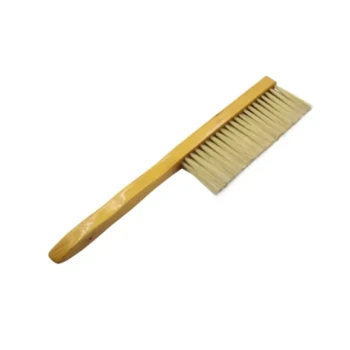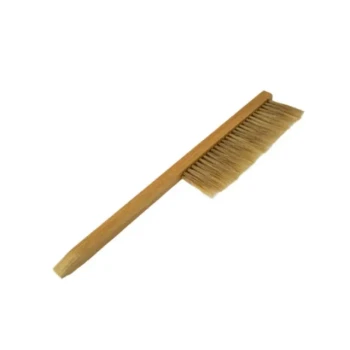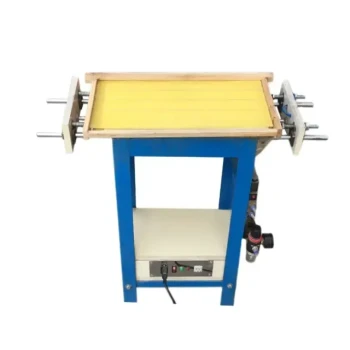The fundamental difference between bottom-mounted and top-mounted pollen traps is a direct trade-off between convenience and pollen purity. Bottom-mounted traps are positioned at the hive's natural entrance, making them easy to engage and disengage, but they tend to collect more hive debris. Top-mounted traps force bees through an upper entrance, yielding exceptionally clean pollen at the cost of being harder to manage and potentially disruptive to the colony.
Your choice of pollen trap is not about which is universally "better," but which best serves your specific goal. Bottom-mounted traps prioritize ease of use and collection volume, while top-mounted traps prioritize the cleanliness of the final product.
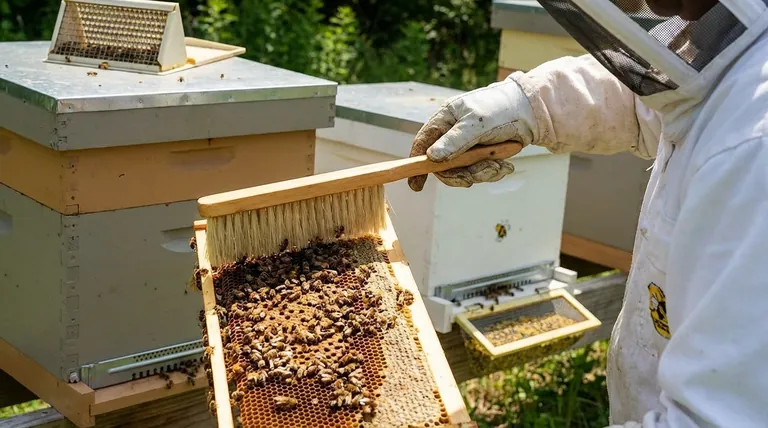
How Trap Location Impacts Your Harvest
A pollen trap works by forcing returning forager bees through a screen or grid that gently scrapes the pollen pellets off their legs and into a collection drawer. The location of this mechanism—at the bottom or top of the hive—creates distinct advantages and disadvantages.
The Bottom-Mounted Trap: The Standard for Convenience
Bottom-mounted traps are the most common design for a reason. They integrate into the standard Langstroth hive setup by replacing the bottom board, becoming the colony's primary entrance and exit.
The Advantage of Usability Most bottom-mounted traps feature a simple bypass or gate. This allows you to "turn on" pollen collection when you want it and "turn it off" when you don't, without disrupting the hive or removing any equipment.
The Drawback: Debris Because they are located at the base of the hive, these traps are prone to collecting debris that falls from the combs above, such as wax flakes, and dirt or grass kicked up near the hive entrance. This means the collected pollen requires more cleaning.
Higher Collection Capacity These traps often have larger collection drawers and are considered a more permanent installation, making them suitable for beekeepers aiming for larger, consistent harvests.
The Top-Mounted Trap: The Choice for Purity
Top-mounted traps are placed above the main hive bodies, typically just under the inner cover. This design forces foraging bees to travel all the way up through the hive and exit/enter through the trap at the top.
The Goal: Cleaner Pollen By collecting pollen far away from the bottom board, top-mounted traps produce a significantly cleaner sample. The pollen falls directly from the bees into a clean drawer, free from most hive debris.
The Cost: Hive Adjustment Bees naturally prefer a bottom entrance. Forcing them to use a top entrance is a major change to their orientation and workflow, which can cause initial confusion and stress within the colony.
The Inconvenience of Removal Unlike bottom traps, most top-mounted designs cannot be easily turned off. To stop collecting pollen, you typically must remove the entire apparatus, which is a more intrusive process.
Understanding the Trade-offs and Risks
Choosing a pollen trap involves more than just comparing two designs. You must consider the impact on your bees and your own management style.
The Core Dilemma: Quality vs. Effort
The central trade-off is clear: Do you want pollen that is easier to collect but requires cleaning, or are you willing to put in more effort for a purer product? Your answer dictates the right trap for you.
Impact on Bee Behavior
Any pollen trap can slightly slow the entry of foragers, which can cause "bearding" at the entrance on hot days. Top-mounted traps add another layer of change by completely rerouting the hive's traffic pattern.
Increased Pest Pressure
The collected pollen in the trap drawer can be a powerful attractant for pests, most notably the Small Hive Beetle. Any trap you use must be monitored and emptied regularly to prevent it from becoming a pest nursery.
Considering the "Front Porch" Alternative
A third common type is the front porch trap. These are smaller units that hang on the front of the hive at the entrance. They are very easy to install and remove but have a much smaller collection capacity and must fit perfectly to prevent bees from bypassing them.
Making the Right Choice for Your Goal
Select your equipment based on a clear understanding of your personal beekeeping objectives.
- If your primary focus is maximum convenience and large-volume collection: A bottom-mounted trap is the most practical and common choice.
- If your primary focus is the highest quality, cleanest pollen for sale or personal use: A top-mounted trap will deliver superior results, but it requires more hive management.
- If you are a hobbyist wanting to experiment with pollen collection: A small front porch trap offers a low-commitment, easily removable starting point.
By aligning your equipment with your specific objectives, you ensure a successful harvest for both you and your hive.
Summary Table:
| Feature | Bottom-Mounted Trap | Top-Mounted Trap |
|---|---|---|
| Primary Advantage | Convenience & Easy On/Off | Exceptionally Clean Pollen |
| Main Disadvantage | Collects More Hive Debris | Difficult to Manage & Remove |
| Best For | Large-Volume, Consistent Harvests | High-Quality Pollen for Sale/Personal Use |
| Hive Impact | Minimal Disruption | Major Rerouting of Bee Traffic |
Ready to Optimize Your Pollen Harvest?
Choosing the right equipment is crucial for your apiary's success. Whether you manage a few hives or a large commercial operation, HONESTBEE supplies durable, high-performance beekeeping supplies and equipment through wholesale-focused operations.
We provide the tools commercial apiaries and distributors need to maximize efficiency and product quality. Contact our experts today to discuss your specific needs and discover how our wholesale solutions can benefit your business.
Visual Guide
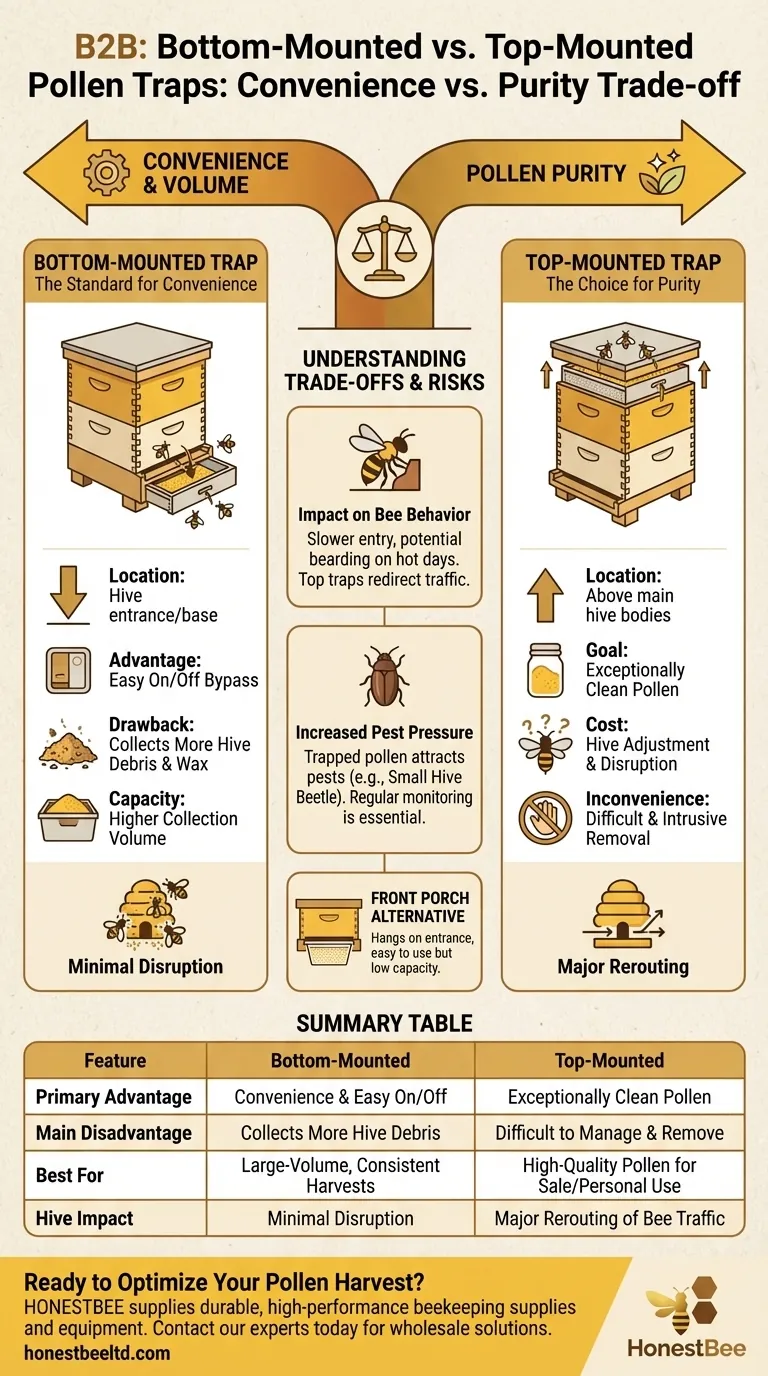
Related Products
- Wooden Bee Brush with Triple Row Artificial Fiber for Beekeeping
- HONESTBEE Advanced Ergonomic Stainless Steel Hive Tool for Beekeeping
- Classic Wooden Bee Brush with Double-Row Boar Bristles
- Full Set Beekeeping Electronic Bee Venom Collector Machine Device for Bee Venom Collecting
- Long Langstroth Style Horizontal Top Bar Hive for Wholesale
People Also Ask
- What are some optional tools that can be useful in beekeeping? Boost Efficiency & Hive Health
- Why do beekeepers use a bee brush? The Essential Tool for Gentle Bee Handling
- What is the purpose of a bee brush? Master Gentle Hive Management for Healthier Bees
- What is the purpose of a bee brush? Gently Manage Your Hive with Precision
- What are the key features of a popular bee brush? Essential Design for Bee Safety and Hive Hygiene
